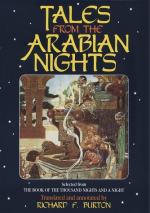(See a paper by Professor E. R. Cowell, LL.D., in the
“Journal of Philology,” 1876, vol. vi.
pp. 222-231.) This legend also exists in Telugu, under
the title of “Sananda Charitra,” of which
the outline is given in Taylor’s “Catalogue
Raisonne of Oriental MSS. in the Government Library,
Madras,” vol. ii. p. 643: Sananda, the
son of Purna Vitta and Bhadra Datta, heard from munis
accounts of the pains of the wicked, and wishing to
see for himself, went to Yama-puri. His coming
had been announced by Narada. Yama showed the
stranger the different lots of mankind in a future
state, in details. Sananda was touched with compassion
for the miseries that he witnessed, and by the use
of the five and six lettered spells he delivered those
imprisoned souls and took them with him to Kailasa.
Yama went to Siva and complained, but Siva civilly
dismissed the appeal.—Under the title of
“The Harrowing of Hell,” the apocryphal
Christian legend was the theme of a Miracle Play in
England during the Middle Ages, and indeed it seems
to have been, in different forms, a popular favourite
throughout Europe. Thus in a German tale Strong
Hans goes to the Devil in hell and wants to serve
him, and sees the pains in which souls are imprisoned
standing beside the fire. Full of pity, he lifts
up the lids and sets the souls free, on which the Devil
at once drives him away. A somewhat similar notion
occurs in an Icelandic tale of the Sin Sacks, in Powell
and Magnusson’s collection (second series, p.
48). And in T. Crofton Croker’s “Fairy
Legends and Traditions of the South of Ireland,”
ed. 1828, Part. ii. p. 30 ff., we read of Soul Cages
at the bottom of the sea, containing the spirits of
drowned sailors, which the bold hero Jack Docherty
set free.
[FN#413] The Rabbins relate that among the Queen of
Sheba’s tests of Solomon’s sagacity she
brought before him a number of boys and girls apparelled
all alike, and desired him to distinguish those of
one sex from those of the other, as they stood in his
presence. Solomon caused a large basin of water
to be fetched in, and ordered them all to wash their
hands. By this expedient he discovered the boys
from the girls, since the former washed merely their
hands, while the latter washed also their arms.
[FN#414] Dr. W. Grimm, in the notes to his “Kinder
und Hausmrchen,” referring to the German form
of the story (which we shall come to by and-by), says,
“The Parrot, which is the fourth story in the
Persian Touti Nameh, bears some resemblance to this”—the
Parrot is the reciter of all the stories in the collection,
not the title of this particular tale.
[FN#415] To Sir Richard Burton’s interesting
note on the antiquity of the lens and its applied
use to the telescope and microscope may be added a
passage or two from Sir William Drummond’s “Origines;
or, Remarks on the Origin of several Empires, States,
and Cities,” 1825, vol. ii. pp. 246-250.
This writer appears to think that telescopes were
not unknown to the ancients and adduces plausible




